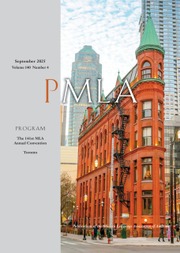No CrossRef data available.
Article contents
Totality, Revisited
Published online by Cambridge University Press: 28 October 2025
Abstract
An abstract is not available for this content so a preview has been provided. Please use the Get access link above for information on how to access this content.

Information
- Type
- Theories and Methodologies
- Information
- Copyright
- © 2025 The Author(s). Published by Cambridge University Press on behalf of Modern Language Association of America
References
Works Cited
Bartolovich, Crystal. “Humanities of Scale.” PMLA, vol. 127, no. 1, Jan. 2012, pp. 115–21.Google Scholar
Buck-Morss, Susan. The Origin of Negative Dialectics: Theodor W. Adorno, Walter Benjamin, and the Frankfurt Institute. Free Press, 1977.Google Scholar
Combahee River Collective. “The Combahee River Collective Statement.” How We Get Free, edited by Taylor, Keeanga-Yamahtta, Books, Haymarket, 2017, pp. 15–27.Google Scholar
Day, Iyko. Alien Capital: Asian Racialization and the Logic of Settler Colonial Capitalism. Duke UP, 2016.Google Scholar
DeLanda, Manuel. A New Philosophy of Society: Assemblage Theory and Social Complexity. Bloomsbury Academic, 2006.Google Scholar
Hall, Stuart. “Race, Articulation and Societies Structured in Dominance.” Stuart Hall: Essential Essays, edited by Morley, David, vol. 1, Duke UP, 2019, pp. 172–221.Google Scholar
Jameson, Fredric. “Cognitive Mapping.” Marxism and the Interpretation of Culture, edited by Nelson, Cary and Grossberg, Lawrence, U of Illinois P, 1988, pp. 347–57.Google Scholar
Kellaway, Kate. “Claudia Rankine: ‘Blackness in the White Imagination Has Nothing to Do with Black People.’” The Guardian, 27 Dec. 2015, www.theguardian.com/books/2015/dec/27/claudia-rankine-poet-citizen-american-lyric-feature.Google Scholar
Koshy, Susan, et al. Introduction. Colonial Racial Capitalism, edited by Koshy et al., Duke UP, 2022, pp. 1–30.Google Scholar
Latour, Bruno. “Why Has Critique Run Out of Steam?” Critical Inquiry, vol. 30, 2004, pp. 225–48.10.1086/421123CrossRefGoogle Scholar
Latour, Bruno, et al. “The Whole Is Always Smaller Than Its Parts.” The British Journal of Sociology, vol. 63, no. 4, 2012, pp. 590–615.10.1111/j.1468-4446.2012.01428.xCrossRefGoogle ScholarPubMed
Love, Heather. “Small Change: Realism, Immanence and the Politics of the Micro.” Modern Language Quarterly, vol. 77, no. 3, 2016, pp. 419–45.10.1215/00267929-3570678CrossRefGoogle Scholar
Robinson, Cedric J. Black Marxism: The Making of the Black Radical Tradition. 3rd ed., U of North Carolina P, 2021.Google Scholar
Spivak, Gayatri Chakravorty. “Can the Subaltern Speak?” Marxism and the Interpretation of Culture, edited by Nelson, Cary and Grossberg, Lawrence, U of Illinois P, 1988, pp. 271–313.Google Scholar
Toscano, Alberto. “Seeing It Whole: Staging Totality in Social Theory and Art.” Sociological Review, vol. 60, no. 1, 2012, pp. 64–83.10.1111/j.1467-954X.2012.02117.xCrossRefGoogle Scholar
Tsing, Anna. Mushroom at the End of the World: On the Possibility of Life in Capitalist Ruins. Princeton UP, 2015.Google Scholar
Tucker-Abramson, Myka. “Make Literary Criticism Great Again.” B2O: Boundary 2 Online, Sept. 2018, www.boundary2.org/2018/09/myka-tucker-abramson-make-literary-criticism-great-again-review-of-david-alworths-site-reading-fiction-art-social-form/.Google Scholar
Weheliye, Alexander G. Habeas Viscus: Racializing Assemblages, Biopolitics, and Black Feminist Theories of the Human. Duke UP, 2014.Google Scholar

